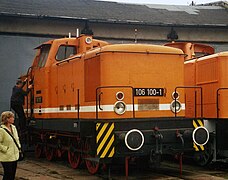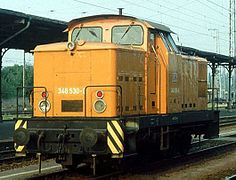DR Class V 60
- V 6010: 13.75 t (30,300 lb)
- V 6012: 15.0 t (33,100 lb)
- V 6010: 55.0 t (121,300 lb)
- V 6012: 60.0 t (132,300 lb)
- 1,500 rpm maximum
- 1,100 rpm maximum (Class 344)
| Performance figures | |
|---|---|
| Maximum speed |
|
| Power output |
|
| Career | |
|---|---|
| Numbers |
|
| Retired | 1992 onwards |
The DR Class V 60 was a class of 0-8-0 diesel-hydraulic locomotives of the Deutsche Reichsbahn intended for medium to heavy shunting service.
In addition to being used by the DR, the locomotives were also found in service on various works and mine railways. About 25 per cent were exported to Comecon countries, and the so-called Non-Socialist Economic Area (Nichtsozialistisches Wirtschaftsgebiet, NSW). For example, the Egyptian State Railways, the Bulgarian State Railways (BDŽ) and Algerian National Railways (SNTF) all received this type of locomotives.


Prototypes
Based on the requirements, LKM Babelsberg built a four-axle prototype locomotive with an asymmetrically arranged driver's cab and drive via a jackshaft and coupling rods. A turbocharged eight-cylinder 8 KVD 21 A engine from VEB Motorenwerk Johannisthal was used.[1] The testing of the prototype V 60 1001 began on 5 February 1959. In September 1959, the second prototype V 60 1002 followed.
-
 Original V 60 D from Babelsberg withouth the overhanging roof.
Original V 60 D from Babelsberg withouth the overhanging roof. -
 Refurbished V 60.10 in the original paintwork in the Chemnitz Hilbersdorf Railway Museum
Refurbished V 60.10 in the original paintwork in the Chemnitz Hilbersdorf Railway Museum -
 346 530 (V 60.12) in Stendal Hauptbahnhof
346 530 (V 60.12) in Stendal Hauptbahnhof -
 Driver's cab of 106 362 as Raban 14
Driver's cab of 106 362 as Raban 14 -
![345 375-0 (Mitteldeutsche Eisenbahn 75)[2] in Rüdersdorf bei Berlin](//upload.wikimedia.org/wikipedia/commons/thumb/6/6c/Kalkwerk-R%C3%BCdersdorf-20060510025055_%28cropped%29.jpg/282px-Kalkwerk-R%C3%BCdersdorf-20060510025055_%28cropped%29.jpg) 345 375-0 (Mitteldeutsche Eisenbahn 75)[2] in Rüdersdorf bei Berlin
345 375-0 (Mitteldeutsche Eisenbahn 75)[2] in Rüdersdorf bei Berlin
With 2,256 units, the design in one of the most frequently built European standard gauge locomotives. 188 locomotives were built by LKM in Babelsberg, the remainder by LEW in Hennigsdorf.[3]
Class 347

In 1986, the last major transport project in East Germany was the new Mukran Ferry Port in Sassnitz. The port was primarily used to provide a trouble-free connection between East Germany and the former Soviet Union. In 1989, five train ferries ran in regular service between Mukran and Klaipėda in Lithuania. Since the Soviet railways have a wider gauge of 1,520 mm (4 ft 11+27⁄32 in), the ferries and 340 ha (840 acres) port facilities were built with 48 km (30 miles) of standard gauge and 24 km (15 miles) of broad gauge tracks.[4]


Livery
In the first series, the original paintwork was red with white stripes; later, the DR painted all shunting locomotives yellow. When this the paint got a bit older and dirtier, the then golden-brown paint was reminiscent of a grilled chicken. There, locomotives in this colour were given the nickname Goldbroiler.[5]
References
- ^ Kampelmann, Klaus; Strüber, Oliver (2020). "Zögerlicher Start und langsamer Fortgang". eisenbahn-magazin (in German). No. 4. p. 45..
- ^ MEG Lokbestand
- ^ Schienenfahrzeuge aus Hennigsdorf bei Berlin (in German). Berlin: Verlag Neddermeyer. 2006. ISBN 978-3-933254-72-6.
- ^ Sievers, Harm (2009). "Auf der Breitspur nach Osten. Positive Perspektiven für den Fährhafen Sassnitz/Mukran". Güterbahnen (in German). No. 1. Düsseldorf: Alba Fachverlag. pp. 32–35. ISSN 1610-5273.
- ^ Weber, Lothar (2014). Der Goldbroiler – Die Baureihe V 60 der DR (in German). Stuttgart: Verlag transpress. ISBN 978-3-613-71490-8.
- Glatte, Wolfgang (2002). "Einfach unverwüstlich. Die Baureihe V 60.10/12". LOK MAGAZIN (in German). Vol. 41, no. 254. Munich: GeraNova Zeitschriftenverlag GmbH. pp. 36–49. ISSN 0458-1822.
- Lüdecke, Michael (2003). "Baureihe V 60.10. Im Führerstand". LOK MAGAZIN (in German). Vol. 42, no. 258. Munich: GeraNova Zeitschriftenverlag GmbH. pp. 52–55. ISSN 0458-1822.
- Weber, Lothar (2014). Der Goldbroiler – Die Baureihe V 60 der DR (in German). Stuttgart: Verlag transpress. ISBN 978-3-613-71490-8.
External links
- Triebfahrzeug-Lexikon auf DB-Loks.de
- Die V 60D-Familie in aller Welt
- v
- t
- e
see also DB locomotives

see also DR locomotives
see also DB locomotives
see also DR locomotives
see also DBAG locomotives




![345 375-0 (Mitteldeutsche Eisenbahn 75)[2] in Rüdersdorf bei Berlin](http://upload.wikimedia.org/wikipedia/commons/thumb/6/6c/Kalkwerk-R%C3%BCdersdorf-20060510025055_%28cropped%29.jpg/282px-Kalkwerk-R%C3%BCdersdorf-20060510025055_%28cropped%29.jpg)








